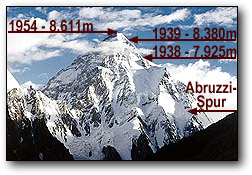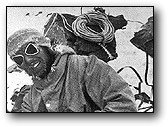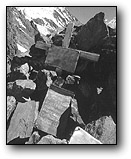|
written by Per
Jerberyd
The climbing history of K2, Mount Godwin Austen (8,611 metres),
from the first try in 1902, until the Italian success in 1954.

In 1902, a
six-man group of European climbers, led by the Englishman Eckenstein, headed for K2. They chose the time before
the monsoon. They first crossed the Baltoro glacier, which with
it's length of 67 kilometres is the world's third largest. The
expedition reached the mountain's foot and planned to make the
attempt directly from the south over the Southeast Ridge, but when
in place they came to the conclusion that the Northeast Ridge is
probably much easier. Several attempts were made without success.
They only reached 6,600 metres - this group had an unrealistic
goal, and didn't realise their limits. At this time, early in the
century, they had no idea of the difficulties in ascending such a
high mountain.
Englishman Eckenstein, headed for K2. They chose the time before
the monsoon. They first crossed the Baltoro glacier, which with
it's length of 67 kilometres is the world's third largest. The
expedition reached the mountain's foot and planned to make the
attempt directly from the south over the Southeast Ridge, but when
in place they came to the conclusion that the Northeast Ridge is
probably much easier. Several attempts were made without success.
They only reached 6,600 metres - this group had an unrealistic
goal, and didn't realise their limits. At this time, early in the
century, they had no idea of the difficulties in ascending such a
high mountain.

Seven years
later it was time for the Duke of Abruzzi's large expedition to
Karakorum and K2. Besides the scientific exploration, this royal
adventurer also had plans for alpine operations. K2 was now
scouted closely and the famous mountain photographer  Vittorio
Sella took a lot of fabulous and legendary photos. To start with,
they tried to reach up through the South East Ridge (that later
was named after the Duke). However, the bearers were not trained
for this exposed climbing (The Sherpas were unfortunately
"unknown" during the early part of the century!). Vittorio
Sella took a lot of fabulous and legendary photos. To start with,
they tried to reach up through the South East Ridge (that later
was named after the Duke). However, the bearers were not trained
for this exposed climbing (The Sherpas were unfortunately
"unknown" during the early part of the century!).
Northeast of K2,
some of the expedition members reached the 6,666 metre high Savoia
Saddle and from there they had a closer look at K2's giant
North-Face. Later, the expedition made an attempt to climb K2's
guardian in the west, the 7,544 metre high Skyang Kangri, but a
giant gorge blocked their way at 6,600 metres. However, later on
Chogolisa (7,654 metres) the Duke reached 7,500 metres with a
resolute attack. This became an absolute high altitude record
until 1922 when it was beaten on Everest.

The Italians
now celebrated their 20 year anniversary in Karakorum. This time
the expedition was lead by the Duke of Spoleto, the nephew of the
Duke of Abruzzi. The scientific leader was Professor Ardito Desio
and it is mainly to his credit that the expedition didn't return
home completely without results.
The plan to try climbing K2 was abandoned and it was decided to
concentrate solely upon scientific work in the Baltoro region.

In 1938 it was
time for the next expedition, organised by the American Alpine
Club and led by Charles Houston, who two years previously had been
on the successful expedition to Nanda Devi. They were confident of
succeeding this time too! They engaged a team of excellent Sherpas,
led by the famous Pasang Kikuli. In the beginning of June the
whole expedition reached the mountain.
On July 1, Camp I was established and several others followed. The
weather looked stabile and clear.
On July 18, Houston and Petzoldt reached the "shoulder"
at 7,740 metres and they  succeeded
in conquering the difficulties on the lower part of the mountain ,
the last high altitude camp was established at 7,530 metres. succeeded
in conquering the difficulties on the lower part of the mountain ,
the last high altitude camp was established at 7,530 metres.
On July 21, Houston and Petzholdt started to push upwards again,
trying to find possible sites for Camp VIII. A place is found
right below the top pyramid. Petzholt however, continued climbing
further on, trying the rocks, his highest point is estimated to be
at 7,925 metres.The sky was clear and the sun warm. Continue or
not? The decision was made and they started the descent. The
expedition results looked promising, for the first time K2's
summit was threatened for real.

Again the
Americans stood in front of K2, this time with the excellent
German-American climber Fritz Wiessner as the leader and again
Pasang Kikuli leading the Sherpas. However, the other climbers
didn't measure up to Wiessner's class, something that would have
serious consequences later on.
Camps I - VII were set up at the same places as the year before
and Camp VIII was established at 7,710 metres, the expedition
member Wolfe remained here when Wiessner and Pasang went on ahead
to set up Camp IX at 7,940 metres. On July 19 Wiessner and Pasang
decided to try for the summit. They climbed through the rocks and
it became extremely arduous. At 6 p.m. they reached about 8,380
metres. Pasang refused to continue, saying it was too late.
Wiessner wanted to continue, the weather was so good and clear
that the climb could be done in the moonlight. Pasang is
immovable, and they start the descent.
During the descent, the rope got stuck in Pasang's crampon and was
torn away from his pack and fell down the abyss. At 2.30 a.m. they
reached Camp IX totally exhausted. Their big chance had slipped
away through their hands; they had been closer to reaching an
8,000-metre summit than anyone before.
The next day, they rested, but the following day another try was
made, taking a different route. Passang had only one crampon.
After major difficulties, they headed back again.
With no supplies remaining the following day, they descended to
camp VIII, where Wolf welcome them with delight, he told them that
during the entire time they were gone, no one had come up from
Camp VII where a bigger supply depot was supposed to be. When  reaching
Camp VII, they found it abandoned. They spent the night there and
the following morning decided that Wolf would remain, while
Wiessner and Pasang continued down to organise a new attack. When
they got to Camp VI it was clear that a catastrophe was near, also
this Camp was abandoned, as were all the other Camps all the way
to Camp II! reaching
Camp VII, they found it abandoned. They spent the night there and
the following morning decided that Wolf would remain, while
Wiessner and Pasang continued down to organise a new attack. When
they got to Camp VI it was clear that a catastrophe was near, also
this Camp was abandoned, as were all the other Camps all the way
to Camp II!
Completely
exhausted both physically and mentally, and suffering from
frostbite, Weissner and Pasang reached Base Camp on July 24. While
they had struggled for the summit, the whole organisation had
completely fallen apart. Against Weissner's orders, the remaining
members of the expedition (that never reached higher then Camp II)
had given the Sherpas orders to abandon all Camps up to number
VII.
Now they had to save Wolfe! After two desperate and failed
attempts, Pasang Kikuli and some other Sherpas managed to reach
Camp VI on July 28. The next morning they got up to Camp VII and
the very exhausted and apathetic Wolfe. Even after being given hot
drinks he couldn't manage to descend immediately, but promised to
be ready the following morning. The Sherpas returned to Camp VI
where they spent the night. A storm with bad weather started to
rage over K2 and they had to wait another day. At dawn on July 31
Pasang and two other Sherpas again climbed to Camp VII while the
fourth, Tsering, remained in camp. A decision was made to somehow
get Wolfe down or at least get a written message from him that
would free them from all responsibility.
This was the last
ever heard from these four men. On August 2, Tsering alone reached
Base Camp and told that none had returned and that no sign of
human life could been seen higher up. Wiesser made a last
desperate rescue attempt but was forced to give up after spending
three days in Camp II waiting out a storm. This meant the end, any
survivor could no longer be found on the mountain. Dudley Wolfe,
Pasang Kikuli, Pasang Kitar and Pintso rest forever on K2. So
ended the second American attempt on K2, with a tragedy. The
expedition got massive criticism from both England and the U.S.A.,
and Wiessner had difficulties defending himself, but he was hardly
the one to blame. Pasang Kikuli was one of the best Sherpas, and
at this time he was equally compared to the now world famous
Tenzing Norgay. More...
|
|
|
 Englishman Eckenstein, headed for K2. They chose the time before
the monsoon. They first crossed the Baltoro glacier, which with
it's length of 67 kilometres is the world's third largest. The
expedition reached the mountain's foot and planned to make the
attempt directly from the south over the Southeast Ridge, but when
in place they came to the conclusion that the Northeast Ridge is
probably much easier. Several attempts were made without success.
They only reached 6,600 metres - this group had an unrealistic
goal, and didn't realise their limits. At this time, early in the
century, they had no idea of the difficulties in ascending such a
high mountain.
Englishman Eckenstein, headed for K2. They chose the time before
the monsoon. They first crossed the Baltoro glacier, which with
it's length of 67 kilometres is the world's third largest. The
expedition reached the mountain's foot and planned to make the
attempt directly from the south over the Southeast Ridge, but when
in place they came to the conclusion that the Northeast Ridge is
probably much easier. Several attempts were made without success.
They only reached 6,600 metres - this group had an unrealistic
goal, and didn't realise their limits. At this time, early in the
century, they had no idea of the difficulties in ascending such a
high mountain. Vittorio
Sella took a lot of fabulous and legendary photos. To start with,
they tried to reach up through the South East Ridge (that later
was named after the Duke). However, the bearers were not trained
for this exposed climbing (The Sherpas were unfortunately
"unknown" during the early part of the century!).
Vittorio
Sella took a lot of fabulous and legendary photos. To start with,
they tried to reach up through the South East Ridge (that later
was named after the Duke). However, the bearers were not trained
for this exposed climbing (The Sherpas were unfortunately
"unknown" during the early part of the century!). succeeded
in conquering the difficulties on the lower part of the mountain ,
the last high altitude camp was established at 7,530 metres.
succeeded
in conquering the difficulties on the lower part of the mountain ,
the last high altitude camp was established at 7,530 metres. reaching
Camp VII, they found it abandoned. They spent the night there and
the following morning decided that Wolf would remain, while
Wiessner and Pasang continued down to organise a new attack. When
they got to Camp VI it was clear that a catastrophe was near, also
this Camp was abandoned, as were all the other Camps all the way
to Camp II!
reaching
Camp VII, they found it abandoned. They spent the night there and
the following morning decided that Wolf would remain, while
Wiessner and Pasang continued down to organise a new attack. When
they got to Camp VI it was clear that a catastrophe was near, also
this Camp was abandoned, as were all the other Camps all the way
to Camp II!